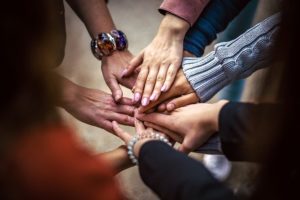
- Church done well can be a community of support and hope.
- Church can provide people with a sense of inclusion, identity and purpose.
- Church can be a place of resurrection.
In my own ministry and preaching, I endeavor to remind people who they are (created, known, beloved), whose they are (God’s), and what they are called to do (discern God’s mission for them in the world). I convey these three goals through the lens of liberation and resurrection as acknowledged in the Christus Victor understanding of what happened in Christ’s death and resurrection. Through Jesus Christ we are called into liberation from that which binds and oppresses us. And, we are called to live into a resurrection story in our own lives. The notions of liberation and resurrection can be vital in anyone’s life, but especially in the lives of those living with mental illness, who are looking for hope and are aided by a sense of worth, dignity, and empowerment.
When we accompany people through a process of restoration, holding their hands as they piece together shattered pieces into whole and holy selves, we get to a point of resurrection and rebirth. Not all restoration is about bringing something or someone back to their original shape. Many shattered pieces of pottery are reformed into something new, with stunning traces of the past mixed with new materials and growth. Dr. Monica Coleman writes of an interesting distinction between her understanding or resurrection vs. rebirth. She writes “…unlike Jesus or Beloved, I was not resurrected. I was reborn. A new person–me” (Coleman, Monica. Bipolar Faith: A Black Woman’s Journey with Depression and Faith. (Minneapolis, MN: Fortress Press, 2016), 224.)
I wonder in what ways language of resurrection is misleading to people experiencing mental health conditions. We may, as clergy, need to explore resurrection with congregants, not as a concept of someone returning to exactly who they were, but rather a nuanced notion of rising and living. Dr. Coleman resonates more with the concept of rebirth, a fresh start which may be hope-giving to congregants living with mental health conditions. Dr. Coleman writes, “We are perpetually perishing, but we are constantly reborn”. (Coleman, Monica. Bipolar Faith: A Black Woman’s Journey with Depression and Faith. (Minneapolis, MN: Fortress Press, 2016), 238. )
- How can our churches become communities of midwives who help with individuals’ rebirths?
- How can we become like the beloved family in the hospital waiting rooms or in the living room as the home birth happens upstairs, who pace with prayerful anticipation, hearts bursting with love
- How can we be that kind of church for one another– churches that encourage rebirth in the most authentic, messy, true ways?
How might we in a progressive Protestant church context reclaim what it is to be born again? We’ve let those two words fall under the eminent domain of the conservative right, given them over to them. We might only hear them again in our more progressive churches in jest, with sarcasm and air quotes indicating our intellectual superiority over those who might submit so fully to the love of God and the reality of what it is to be human. But, we are not superior. We are perhaps instead envious of the power of the words and the hope they convey for brand new life.
So, dream with me.

Rev. Dr. Ciarán Osborn (he/him)
Rev. Dr. Ciarán Osborn is an ordained minister in the United Church of Christ, serving in the Boston metro area. He has served as Pastor of several UCC churches in the Boston area as well as in clinical Chaplain positions. Throughout his ministry, Rev. Ciarán has officiated weddings, baptisms, and memorial services in the wider community.
Rev. Ciarán also lives with chronic mental health conditions. He writes, teaches, and preaches regularly on the topics of mental health, mental illness, and faith. Rev. Ciarán writes for the United Church of Christ Mental Health Network. Ciarán is a board game nerd and hiking and Krav Maga enthusiast. His family lives in the Boston area and they share their life with numerous dogs and chickens.